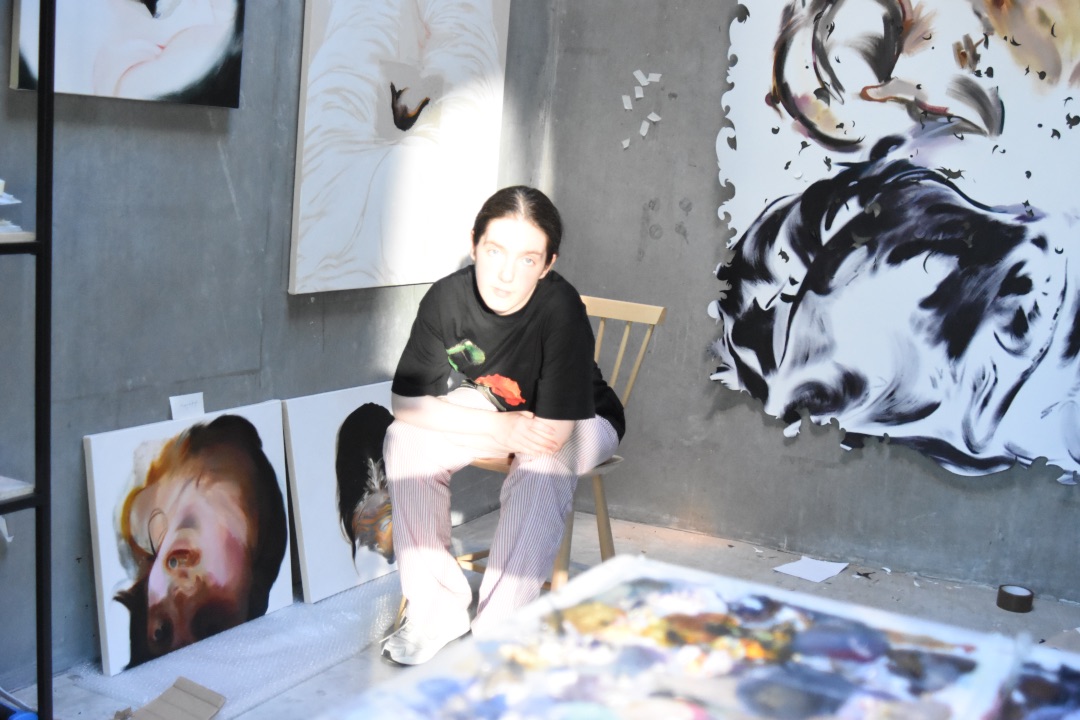Sian Costello: Hot Child

Ormston House is excited to announce Sian Costello’s solo exhibition Hot Child.
Born at the end of the last century, Sian Costello belongs to a generation of artists at the fore of a renaissance in figurative painting. For the past decade, this tendency has been sustained by those who portray the human form as a cradle of sensation, a locus of agency, and a carrier of meaning. That the focus of artists would return to the human body seems inevitable in our virtualised age, in which the concept of what constitutes corporeality – and ultimately our very humanness – is called into question. Simultaneously, the relationship between desire and physical reality (as opposed to augmented reality) is rapidly changing as touch screens become the site of personal and sexual expression.
A concern with exploring sensuality via paint is tangible in this solo show by Costello. The subjects depicted here, and the means by which they are executed, communicate a libidinal exuberance. Take for example Le Gubbeen I and II (2023), in which fleshy forms writhe in vibrational ecstasy. These two paintings, like several others here, evoke Hélène Cixous’ definition of the term jouissance as “potentially sexual rapture that combines mental, physical and spiritual aspects of female experience, bordering on mystical communion”. Religious or sexual rapture can also be seen on the face in the evocatively titled Hussey de Burgh.¹ With head thrown back and mouth open in a moan, she evokes the passions of Saint Teresa, as sculpted by Bernini in his baroque tour-de-force.
Looking at the artworks here, one sees Costello has derived pleasure from the process of producing them. In My Own One and Only I and II (2024), recognisable anatomical details are married with gestural abstraction. Tight zones of meticulously-applied paint are situated next to expansive fields where broad, manual sweeps of colour trace the index of the artist’s expressive motions. Details of hands and faces are worked up against a backdrop of negative space, and in some places, raw canvas reveals itself. A movement away from representation so that areas of compositions teeter into abstraction is a notable development. Discussing this evolution, Costello states it was prompted by ecclesiastical interiors encountered on a recent residency in Denmark. The aesthetic impact of the “pre-Reformation frescoes covered in whitewash” from which “fragments of stories poke through the sea of white has led me to resist that urge to fill the canvas completely”.²
Costello balances a deference for the tradition of painting with a healthy appetite for experimentation. This is evident in the process of incising and slitting open the surface upon which she works; the edges of the two largest works in the show are carefully cut out, lace-like, but might also on first glance appear frayed or moth-eaten.
While some of the larger works here are defined by a sense of abandon, smaller pieces and drawings show a particular restraint. These pieces underscore the artist’s technical skills as a draftsperson with an inherent understanding of the contours of the human form.
The series entitled Hot Child (2024) possesses a spare intensity and is an essential component to this show in demonstrating Costello’s ongoing use of herself as a life model. The erotic charge of this suite is intentionally complicated, since they seem to depict pubescent girls. The title is taken from a 1978 hit by Anglo-Canadian musician Nick Gilder. Allegedly about the tragedies of child prostitution, this song resulted in Gilder being given the queasy sobriquet “Nabokov of the jukebox” by Rolling Stone. Elaborating upon her decision to combine these referents, Costello states that she is motivated by the desire to “examine perceived notions of good taste – what belongs on a canvas or within a frame, and who gets to enjoy and profit from it. Fracturing images is my way of opening up the hidden narratives of the players involved in the portrayal of women, from art history to the present.”³
The history of art is a vital touchstone for Costello, and she refers to it as a means of subverting the male gaze. While earlier works betrayed an interest in the Rococo fripperies of artists such as Fragonard and Boucher, recent works such as Bee Sucks, Bídeach, Bisou (2024) show the influence of later painters such as Whistler. In Costello’s paintings, such historical references are altered, repurposed, and merged with images of herself. In this way, her work can be seen as a retort to centuries of European painting in which female bodies are objectified as an artifice shaped according to male predilections. Using what she describes as “performative self-portraiture”, Costello interrogates legacies of female representation while conveying her own subjectivity – and, by extension, that of others.
¹The title of this painting is taken from U.H. Hussey De Burgh, author of the 1878 book The Landowners of Ireland A comprehensive survey of landowners across the island of Ireland in the late 19th century.
²Interview with artist, summer 2024
³ibid.
Please join us for the launch on Thursday, 25 July from 7–9pm. Admission is free and all are welcome. The exhibition will run from 26 June to 31 August.
Ormston House is supported by the Arts Council of Ireland and Limerick City and County Council.
Limerick City
